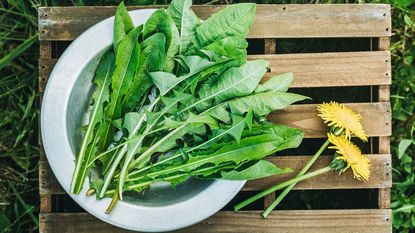Top 10 Surprising Plants You Can Eat


We all have them lurking somewhere within the landscape, or our gardens. WEEDS! They drive us nuts as we tirelessly pick, pull, hoe, spray and curse their presence. But did you know that many of these pesky plants have another more endearing and useful side? What if you could look at them differently, almost lovingly? What?! It's true. A number of common weeds are actually edible and, as such, can be welcome additions to our gardens instead of the bane of our existence.
Here are 10 surprising "weed" plants you can eat:
1. Dandelion. The quintessential "weed," dandelion plants are easily identifiable, ubiquitous, and completely edible. Eat the young greens and flowers raw in salads, or cook up the more mature leaves and roots like any other vegetable.
2. Nettles. The leaves of stinging nettles have to be cooked thoroughly in order to wilt those prickly hairs, but once they are, these plants are quite tasty and can be used like any other greens.
3. Chickweed. A common weed that grows in mats with tiny white flowers, chickweed is a plant that normally drives gardeners insane. That needn't be the case, however. The leaves of this plant can actually be eaten raw or cooked and are extremely high in iron.
4. Purslane. Another matting weed that seems to pop up overnight, this plant's succulent leaves and stems have a somewhat acidic taste and are very high in calcium, iron, vitamin C, and omega-3 fatty acids. Now you have a reason to keep those purslane plants around.
5. Chicory. While chicory is often viewed as a weed, the plant's pretty blue flowers actually make wonderful additions to an ornamental bed. But that's not all it's good for. The leaves can be used in teas or as greens, and the roots (along with the leaves) also make an exceptional coffee substitute.
Gardening tips, videos, info and more delivered right to your inbox!
Sign up for the Gardening Know How newsletter today and receive a free download of our most popular eBook "How to Grow Delicious Tomatoes."
6. Violet. You may become annoyed with all the wild violets popping up in the yard, but these flowers, like their pansy relatives, can be useful in the kitchen. Both the leaves and flowers (which bloom in late winter and early spring) are edible and rich in vitamins with a delicate, slightly minty flavor.
7. Daylily. We often refer to these tenacious orange flowers as ditch lilies, as the plants can be commonly found growing along roadsides and in ditches, as well as throughout our gardens. But did you know these old-fashioned daylilies are edible? That's right. The shoots, buds, flowers and tubers are edible, and nothing beats those fried daylily flower fritters.
8. Lambsquarter. Lambsquarter, sometimes also called wild spinach, this leafy green weed can be eaten raw or cooked, just like its more traditional namesake. It is loaded with nutrients such as iron, protein, and vitamin B2.
9. Plantain. Not to be confused with the banana-like fruit, broadleaf plantain is a low-growing weed native to Eurasia that produces edible leaves and seed shoots, sometimes called poor man's asparagus.
10. Cattail. We love the looks of the corn-dog-like appearance of cattails, but not necessarily their invasiveness in pond areas. That said, these famous water plants are actually almost entirely edible. Early in the season the brown tops can be steamed and eaten just like corn on the cob (they even have a similar flavor). The leaves and stems can also be boiled and eaten.
Disclaimer: The contents of this article is for educational and gardening purposes only. Before using or ingesting ANY herb or plant for medicinal purposes or otherwise, please consult a physician, medical herbalist or other suitable professional for advice.

The only child of a horticulturist and an English teacher, Liz Baessler was destined to become a gardening editor. She has been with Gardening Know how since 2015, and a Senior Editor since 2020. She holds a BA in English from Brandeis University and an MA in English from the University of Geneva, Switzerland. After years of gardening in containers and community garden plots, she finally has a backyard of her own, which she is systematically filling with vegetables and flowers.
-
 Grow a Bathroom Oasis: 8 Best Bathroom Plants With No Light or Low Light
Grow a Bathroom Oasis: 8 Best Bathroom Plants With No Light or Low LightSome apartment dwellers grow the best bathroom plants with no light or low light. Read how one of our favorite plant lovers does it in the big city.
By Teo Spengler
-
 "My Worst Mistake" – Gardeners Share 10 Hard-Learned Lessons
"My Worst Mistake" – Gardeners Share 10 Hard-Learned LessonsGardeners never stop learning, and sometimes our mistakes are the best teachers. But why not save time and heartache by learning from other gardeners' failures?
By Melanie Griffiths